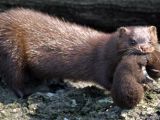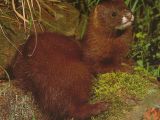1.There are two species of minks. Even if they belong to the same genus of the stoats, weasels and polecats, Mustela, they do not have a common origin, but are the result of convergent evolution. This is proven by skull characters, karyotype (number and shape of the chromosomes), immunology.
2.Minks are solitary creatures. The male defends a territory of 2-5 km (1.2-3 mi) on a river, about 8-20 hectares. This territory comprises the territories of several females. The adult makes 2-10 galleries in which it spends most of its time, in the nest sheathed with leaves, grass, hair, feathers. Minks are rather nocturnal and do not hibernate.
3.Their prey consists of mammals (rabbits, muskrats, various rodents, and others), birds (like ducks), amphibians, reptiles, fish, crayfish. Minks consume fish especially during the winter, when they are benumbed.
4.Minks swim using their rear limbs. The fur is extremely dense. The eyesight is mediocre under the water. The swim speed is 46-54 cm (1.5-1.8 ft) per second.
5.Male minks are larger than females. Breeding takes place in February-March. Gestation lasts 45-70 days, and the births occur in April-May. Nests are made of feathers and hairs. The number of offspring is 4-6 (but up to 17 in captivity) (2 to 7 for the European mink). The newborn weighs 12 grams, and it is nude and blind. At the age of 7 weeks, they have 40 % of the adult size, and by the age of 8 weeks, they are weaned. Wild minks live less because of the parasites, diseases, competition and predators.
In Siberia, breeding takes place in February-March for the American mink, and March-April for the European mink. The males of American mink fecundate the females of European mink, the resulting embryos do not develop and are aborted , and the European mink females cannot reproduce in that year.
6.The American mink (Mustela vison) has a white chin. The length of head and body is 40-50 cm (1.3-1.6 ft), while the tail makes 15-25 cm (0.5-0.8 ft). It weighs up to 1 kg (2.2 pounds). Its natural areal is in US (down to California and Florida), Alaska and Canada, but bewildered populations are found in Europe. It was introduced voluntarily in the ex USSR (Kola peninsula, Kamchatka, Tatarstan, Altai mountains, eastern Siberia, Far East). Sexual maturity is achieved by the age of 10 months and the maximum longevity in captivity is of 8-10 years. It has 8 pairs of mammary glands. Territory is marked using the secretion of the anal glands.
7.The European mink (Mustela lutreola) has a white muzzle and weighs 650-950 g (1.4-2.1 pounds).
It has several races: lutreola in Finland, cylipena in northwestern Russia, biedermanni in France and Spain(around the Bay of Biscay), transylvannica in Romania, turani at north of Caucasus, navikovi around Moscow and binominata in Caucasus. The eastern limit of the European mink is at the Ural mountains.

 14 DAY TRIAL //
14 DAY TRIAL // 

